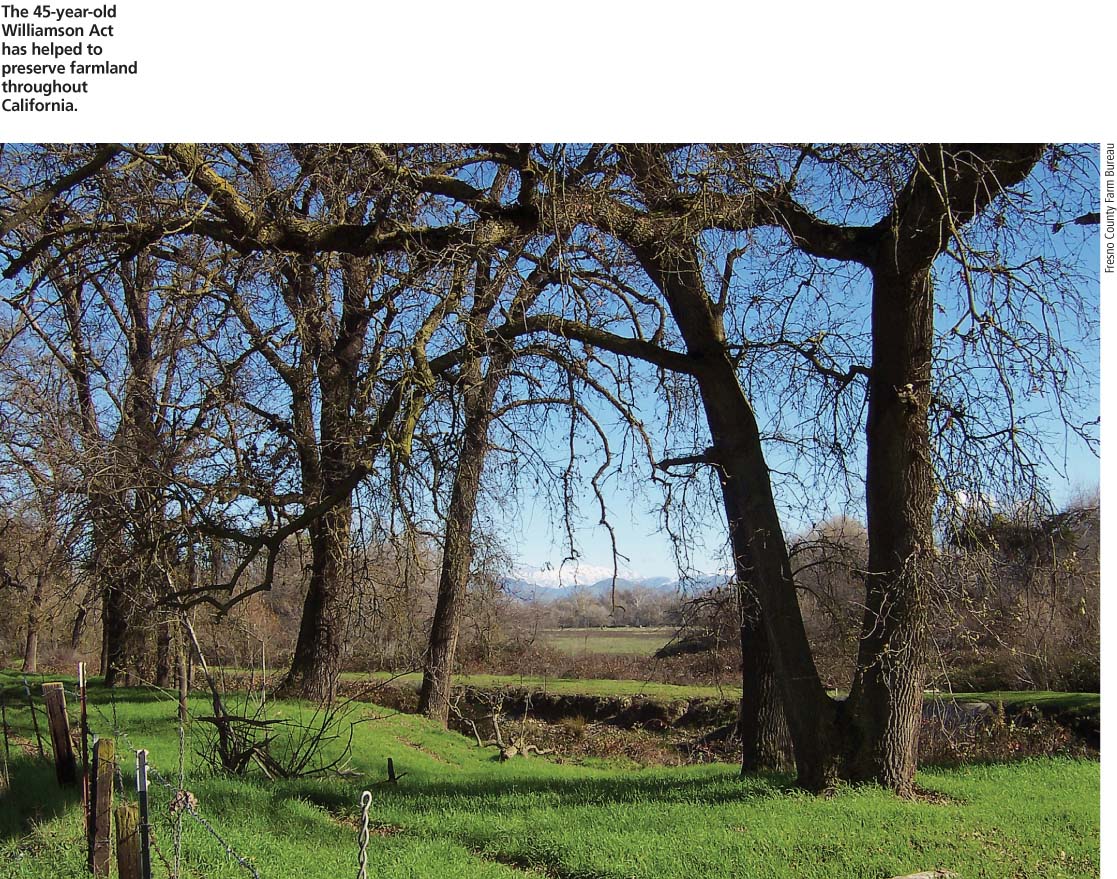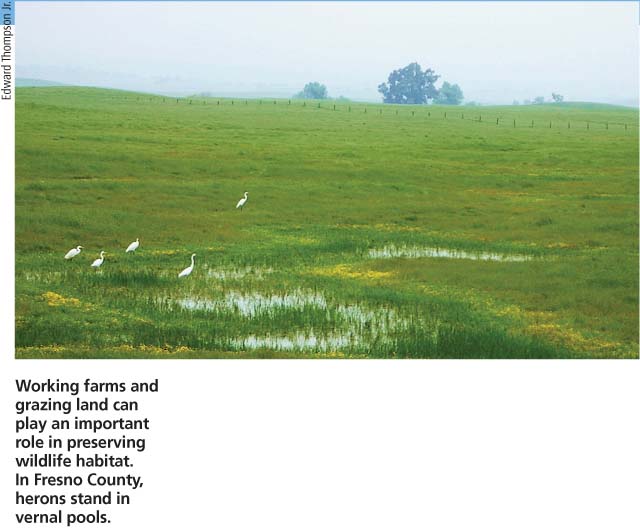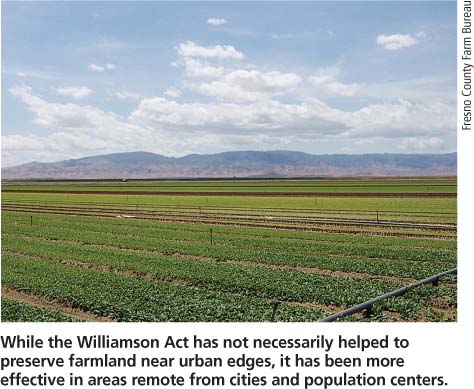All Issues
Outlook: Budget cuts threaten the Williamson Act, California's longstanding farmland protection program
Publication Information
California Agriculture 64(3):118-120.
Published July 01, 2010
PDF | Citation | Permissions
Full text
Thousands of California farmers and ranchers, owning about half of all the agricultural acres in California, have their properties enrolled in the Williamson Act. Many of them and others are worried about the continuity of the 45-year-old, state-local government program that restricts the conversion of farms and ranches to urban uses by providing property-tax reductions to landowners. At issue is the elimination in the state budget of the subventions (fiscal aid) that compensate counties for all or a part of their property-tax losses.
Intense lobbying by agricultural and other groups has opened up the possibility that subventions could be restored in the 2010-11 state budget as a temporary measure, pending agreement on a permanent way to fund the program that does not rely on the state's general fund. The problem is rooted in the current fiscal crisis that overwhelms both state and county governments. This is not the first time that Williamson Act subventions have been threatened by budget shortfalls, but with a continuing state government deficit of about $20 billion and big funding gaps for counties, the current crisis is the most severe since the state began paying subventions in 1971.
Even without the subventions, the core part of the program — long-term contracts between landowners and county governments and a few cities that link land restrictions to property-tax benefits — could continue to exist. The landowner-county contractual relationship is legally independent of the state-county fiscal relationship. But in practice, the two processes are closely connected. For if they permanently lose fiscal support, most counties probably would reluctantly exit from the program by not renewing existing contracts to gain back the foregone property-tax revenues. As contracts wind down, farmland owners would automatically lose their tax benefits and in 9 years could begin to develop their properties.
How it works
Enacted in 1965 and named after its legislative sponsor, Assemblyman John Williamson of Kern County, the program now covers 16.6 million acres, about half of California's agricultural land and one-third of all privately owned land in the state. Fifty-three of 58 counties currently participate (except Alpine, Del Norte, Inyo, San Francisco and Yuba counties).
Participation in the Williamson Act is voluntary for both landowners and counties (see sidebar). The contracts run for a minimum of 10 years and are automatically renewed every year unless either party takes action to terminate.
State spending on subventions totaled about $37 million annually until recently. For individual counties in the program, the annual subvention has ranged from a few thousand dollars to between $1 million and $5 million for the nine large agricultural counties in the Central Valley. In relation to total budgets, these are not large amounts. But because they represent precious discretionary (general fund) dollars, the lost subventions are big hits for already distressed counties, which for several years have had to lay off large numbers of employees and drastically cut general fund programs.
County and landowner impacts
As much as county officials support the farmland protection objectives of the Williamson Act, many say they cannot afford the property-tax hits. One county, Imperial, has already started the nonrenewal process, and others have announced that they will probably follow if subventions are not restored in the 2010-11 state budget. A few counties may bite the fiscal bullet and continue the program. Much depends on how county boards of supervisors balance their commitments to farmland protection with the condition of their general funds. In the meantime, some counties have stopped accepting new applications from landowners, according to a February survey of its members by the California State Association of Counties, with the general mood described as a “holding pattern” pending further state government action or inaction.
What will landowners do if they lose the property-tax benefits? An unknown number certainly will try to sell their agricultural properties for future development, judging from anecdotal accounts in several newspapers. But “cash out” opportunities are limited by location and other factors. Most acres under contract are in remote areas not suitable for major urban development. Of course, there is a market in California for scattered, country home sites, but landowner opportunities for parcelization are restricted by requirements such as water supply and road access, and by other county planning and land-use regulations.
How effective?
The objectives of the Williamson Act and the complementary subventions are widely supported by agricultural groups, landowners, county governments, environmentalists and others. For its backers the program is a successful case of converging public and private interests, achieving long-term land conservation while helping the economic bottom line of farmers and ranchers.
Major features of the Williamson Act
Agricultural preserves. Enrolled land must be located within county-designated agricultural preserves of at least 100 acres, a provision intended to create large concentrations of acres under contract.
Farmland security zone. Added to the basic Williamson Act in 1998, this version of the program provides for 20-year contracts in return for greater landowner property-tax reductions.
Long-term contracts. Participating landowners sign 10-year contracts with their counties restricting their properties to agricultural or other open space uses. Unless either party takes action to terminate a contract, it is automatically renewed every year for another year — resulting in a rolling 10-year term.
Not mandated (voluntary). Participation is voluntary for both counties (and cities) and agricultural landowners.
Subventions. Up until 2009-10, the state compensated counties for their property-tax losses according to a per-acre formula that paid more for prime than nonprime land.
Termination. The most commonly used technique for removing land from the program is contract “nonrenewal,” initiated either by the landowner or county and resulting in a 9-year phase-out. Contracts can also be terminated in other ways, including: (1) immediate “cancellation,” requiring findings of unusual circumstances and landowner penalty payments; (2) “acquisition” of property by public agencies; and (3) “city annexation” in certain cases.
Use value assessment. Enrolled land is assessed for property-tax purposes at the value of its agricultural production, instead of the generally higher market or Proposition 13 value.
Working farms and grazing land can play an important role in preserving wildlife habitat. In Fresno County, herons stand in vernal pools.
Yet there are critics who question the program's effectiveness in holding the line on farmland conversion. For example, the Legislative Analyst, the fiscal advisor to the California Legislature, has recommended on several occasions the deletion of subventions on the grounds that the program does not narrowly focus on lands actually at risk of development.
In part the critics are correct: The Williamson Act has done little to limit the rate and volume of farmland conversions in the path of city expansion. Two historic conditions are responsible: (1) the reluctance of landowners on city edges, anticipating development opportunities, to enroll in the program; and (2) the ability of cities in the past to protest enrollments within 1 mile of their borders, effectively terminating such contracts when city annexation occurs. (The latter condition has had less impact in recent years, because as cities grow beyond the 1-mile limit they increasingly are adjacent to contracted land that they did not protest at the time of original enrollment.)
On the other hand, the program has been more effective in less visible terms, as suggested by a 1989 UC study. In areas remote from cities and other population centers where most land covered by the Williamson Act is located, the program has helped to control farmland conversions and block development — reducing the extent of leapfrog development and sprawl in rural California (see pages 121 and 129).
The Williamson Act is not solely responsible for this outcome; other policies and programs have contributed. Since its enactment in 1965, the preferential tax program has been supplemented by such state-local measures as: (1) environmental review of development proposals under the California Environmental Quality Act (CEQA), (2) regulation of city expansion, (3) restrictive agricultural zoning in some counties, (4) urban growth boundaries created in some jurisdictions and (5) agricultural easement programs. Some of these other policies and programs are more or just as effective in maintaining farmland in particular areas, but the Williamson Act still stands out in the sheer volume of agricultural acres it covers throughout California.
What is next?
Not restoring subvention funds in the 2010-11 budget signals a virtually permanent elimination of this aid to counties. Without other assistance to protect their budgets, most counties with substantial acres in the program probably would pull out through contract nonrenewals. This is a process that takes 9 years to complete, delaying any landowner efforts to convert their agricultural properties to urban use.
The subvention crisis has stimulated much discussion about changing the method by which landowner tax benefits are funded. In spring 2010, agricultural organizations and state government officials were considering a variety of alternatives to save the program by shifting county aid away from the state's general fund. These included having landowners pay for a portion of their property-tax benefits; funding subvention payments from one or more dedicated revenue sources, such as oil severance taxes or property transfer fees; and allowing counties to capture certain local revenues such as parcel fees. Such proposals, as well as providing state income tax credits to participating landowners in place of the property-tax benefits, were suggested in a hearing conducted by the Senate Local Government Committee in March.
With the 2010-11 state budget year due to begin July 1, the one certainty is that the time for resolving the subvention problem is running out.







